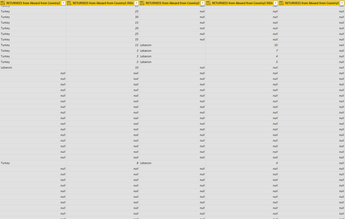FabCon is coming to Atlanta
Join us at FabCon Atlanta from March 16 - 20, 2026, for the ultimate Fabric, Power BI, AI and SQL community-led event. Save $200 with code FABCOMM.
Register now!- Power BI forums
- Get Help with Power BI
- Desktop
- Service
- Report Server
- Power Query
- Mobile Apps
- Developer
- DAX Commands and Tips
- Custom Visuals Development Discussion
- Health and Life Sciences
- Power BI Spanish forums
- Translated Spanish Desktop
- Training and Consulting
- Instructor Led Training
- Dashboard in a Day for Women, by Women
- Galleries
- Data Stories Gallery
- Themes Gallery
- Contests Gallery
- QuickViz Gallery
- Quick Measures Gallery
- Visual Calculations Gallery
- Notebook Gallery
- Translytical Task Flow Gallery
- TMDL Gallery
- R Script Showcase
- Webinars and Video Gallery
- Ideas
- Custom Visuals Ideas (read-only)
- Issues
- Issues
- Events
- Upcoming Events
View all the Fabric Data Days sessions on demand. View schedule
- Power BI forums
- Forums
- Get Help with Power BI
- Desktop
- Combine text from multiple columns into one
- Subscribe to RSS Feed
- Mark Topic as New
- Mark Topic as Read
- Float this Topic for Current User
- Bookmark
- Subscribe
- Printer Friendly Page
- Mark as New
- Bookmark
- Subscribe
- Mute
- Subscribe to RSS Feed
- Permalink
- Report Inappropriate Content
Combine text from multiple columns into one

i have Country1, Country2, Country3
and beside each column one column for the number of individual
i need to disply them in multi-row card as one value without duplication
is there a way to do so?
Solved! Go to Solution.
- Mark as New
- Bookmark
- Subscribe
- Mute
- Subscribe to RSS Feed
- Permalink
- Report Inappropriate Content
Hi @NourJ ,
There are two solutions. Please download the demo from the attachment.
1. Transform the data using M.
Result = Table.Combine({Table.RenameColumns(Table.SelectColumns(#"Changed Type", {"Col1", "Value1"}), {{"Col1", "Col"}, {"Value1", "Value"}}),
Table.RenameColumns(Table.SelectColumns(#"Changed Type", {"Col2", "Value2"}), {{"Col2", "Col"}, {"Value2", "Value"}}),
Table.RenameColumns(Table.SelectColumns(#"Changed Type", {"Col3", "Value3"}), {{"Col3", "Col"}, {"Value3", "Value"}})})
2. Create a new table and establish three relationships.
Cols = FILTER ( DISTINCT ( UNION ( VALUES ( Table2[Col1] ), VALUES ( Table2[Col2] ), VALUES ( Table2[Col3] ) ) ), [Col1] <> BLANK () )
Measure = SUM ( Table2[Value1] ) + CALCULATE ( SUM ( Table2[Value2] ), USERELATIONSHIP ( Cols[Col1], Table2[Col2] ) ) + CALCULATE ( SUM ( Table2[Value3] ), USERELATIONSHIP ( Cols[Col1], Table2[Col3] ) )
Best Regards,
If this post helps, then please consider Accept it as the solution to help the other members find it more quickly.
- Mark as New
- Bookmark
- Subscribe
- Mute
- Subscribe to RSS Feed
- Permalink
- Report Inappropriate Content
UNION the VALUES of your columns together and then do a DISTINCT perhaps.
Follow on LinkedIn
@ me in replies or I'll lose your thread!!!
Instead of a Kudo, please vote for this idea
Become an expert!: Enterprise DNA
External Tools: MSHGQM
YouTube Channel!: Microsoft Hates Greg
Latest book!: DAX For Humans
DAX is easy, CALCULATE makes DAX hard...
- Mark as New
- Bookmark
- Subscribe
- Mute
- Subscribe to RSS Feed
- Permalink
- Report Inappropriate Content
@Greg_Decklerhow i can union them, i forgot to mention that this data is being updated mothly. so how can i union them ? is there a formula to do it or i had to add extra table manualy?
- Mark as New
- Bookmark
- Subscribe
- Mute
- Subscribe to RSS Feed
- Permalink
- Report Inappropriate Content
Hi @NourJ ,
Can you post the expected result based on your snapshot, please? Would like the unique value in a column or unioning the three columns?
Best Regards,
If this post helps, then please consider Accept it as the solution to help the other members find it more quickly.
- Mark as New
- Bookmark
- Subscribe
- Mute
- Subscribe to RSS Feed
- Permalink
- Report Inappropriate Content
This is the result that i want to get, i want to have a column have the value of the three columns to usein slicer and in the multi-row card.
is it possible to have it like the attached pic?!
- Mark as New
- Bookmark
- Subscribe
- Mute
- Subscribe to RSS Feed
- Permalink
- Report Inappropriate Content
Hi @NourJ ,
There are two solutions. Please download the demo from the attachment.
1. Transform the data using M.
Result = Table.Combine({Table.RenameColumns(Table.SelectColumns(#"Changed Type", {"Col1", "Value1"}), {{"Col1", "Col"}, {"Value1", "Value"}}),
Table.RenameColumns(Table.SelectColumns(#"Changed Type", {"Col2", "Value2"}), {{"Col2", "Col"}, {"Value2", "Value"}}),
Table.RenameColumns(Table.SelectColumns(#"Changed Type", {"Col3", "Value3"}), {{"Col3", "Col"}, {"Value3", "Value"}})})
2. Create a new table and establish three relationships.
Cols = FILTER ( DISTINCT ( UNION ( VALUES ( Table2[Col1] ), VALUES ( Table2[Col2] ), VALUES ( Table2[Col3] ) ) ), [Col1] <> BLANK () )
Measure = SUM ( Table2[Value1] ) + CALCULATE ( SUM ( Table2[Value2] ), USERELATIONSHIP ( Cols[Col1], Table2[Col2] ) ) + CALCULATE ( SUM ( Table2[Value3] ), USERELATIONSHIP ( Cols[Col1], Table2[Col3] ) )
Best Regards,
If this post helps, then please consider Accept it as the solution to help the other members find it more quickly.
- Mark as New
- Bookmark
- Subscribe
- Mute
- Subscribe to RSS Feed
- Permalink
- Report Inappropriate Content
Helpful resources

Power BI Monthly Update - November 2025
Check out the November 2025 Power BI update to learn about new features.

Fabric Data Days
Advance your Data & AI career with 50 days of live learning, contests, hands-on challenges, study groups & certifications and more!


